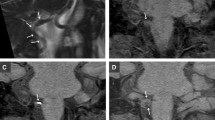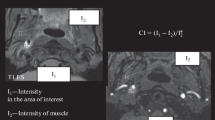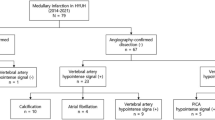Abstract
Introduction
We investigated the efficacy of three-dimensional black blood T1-weighted imaging (3D-BB-T1WI) using a variable refocusing flip angle turbo spin-echo sequence in the diagnosis of intracranial vertebral artery dissection (VAD).
Methods
Sixteen consecutive patients diagnosed with intracranial VAD underwent magnetic resonance imaging that included 3D time-of-flight-MRA, axial spin-echo T1-weighted images (SE-T1WI) and oblique coronal 3D-BB-T1WI sequences. The visualization, morphology and extent of intramural haematomas were assessed and compared among the sequences. Results obtained by digital subtraction angiography (DSA), 3D-angiography and/or 3D-CT angiography (CTA) were used as standards of reference.
Results
3D-BB-T1WI revealed intramural haematomas in all cases, whereas SE-T1WI and magnetic resonance angiography (MRA) failed to reveal a haematoma in one case and three cases, respectively. The mean visualization grading score for the intramural haematoma was the highest for 3D-BB-T1WI, and there was a statistically significant difference among the sequences (p < 0.001). At least a portion of the intramural haematoma was distinguishable from the lumen on 3D-BB-T1WI, whereas the haematomas were entirely indistinguishable from intraluminal signals on MRA in two cases (12.5 %) and on SE-T1WI in one case (6.3 %). 3D-BB-T1WI revealed the characteristic crescent shape of the intramural haematoma in 14 cases (87.5 %), whereas SE-T1WI and MRA revealed a crescent shape in only 7 cases (43.8 %) and 8 cases (50 %), respectively. In a consensus reading, 3D-BB-T1WI was considered the most consistent sequence in representing the extent and morphology of the lesion in 14 cases (87.5 %), compared to DSA and CTA.
Conclusion
3D-BB-T1WI is a promising method to evaluate intramural haematoma in patients with suspected intracranial VAD.


Similar content being viewed by others
References
Provenzale JM, Sarikaya B (2009) Comparison of test performance characteristics of MRI, MR angiography, and CT angiography in the diagnosis of carotid and vertebral artery dissection: a review of the medical literature. Am J Roentgenol 193:1167–1174
Rodallec MH, Marteau V, Gerber S et al (2008) Craniocervical arterial dissection: spectrum of imaging findings and differential diagnosis. Radiographics 28:1711–1728
Debette S, Leys D (2009) Cervical-artery dissections: predisposing factors, diagnosis, and outcome. Lancet Neurol 8:668–678
Willinsky R, Taylor S, TerBrugge K et al (2003) Neurologic complications of cerebral angiography: prospective analysis of 2,899 procedures and review of the literature. Radiology 227:522–528
Kaufmann TJ, Huston J 3rd, Mandrekar JN et al (2007) Complications of diagnostic cerebral angiography: evaluation of 19,826 consecutive patients. Radiology 243:812–819
Lévy C, Laissy JP, Raveau V et al (1994) Carotid and vertebral artery dissections: three-dimensional time-of-flight MR angiography and MR imaging versus conventional angiography. Radiology 190:97–103
Kitanaka C, Tanaka J, Kuwahara M et al (1994) Magnetic resonance imaging study of intracranial vertebrobasilar artery dissections. Stroke 25:571–575
Mascalchi M, Bianchi MC, Mangiafico S et al (1997) MRI and MR angiography of vertebral artery dissection. Neuroradiology 39:329–340
Auer A, Felber S, Schmidauer C et al (1998) Magnetic resonance angiographic and clinical features of extracranial vertebral artery dissection. J Neurol Neurosurg Psychiatry 64:474–481
Leclerc X, Lucas C, Godefroy O et al (1999) Preliminary experience using contrast-enhanced MR angiography to assess vertebral artery structure for the follow-up of suspected dissection. Am J Neuroradiol 20:1482–1490
Chen CJ, Tseng YC, Lee TH et al (2004) Multisection CT angiography compared with catheter angiography in diagnosing vertebral artery dissection. Am J Neuroradiol 25:769–774
Vertinsky AT, Schwartz NE, Fischbein NJ et al (2008) Comparison of multidetector CT angiography and MR imaging of cervical artery dissection. Am J Neuroradiol 29:1753–1760
Elijovich L, Kazmi K, Gauvrit JY et al (2006) The emerging role of multidetector row CT angiography in the diagnosis of cervical arterial dissection: preliminary study. Neuroradiology 48:606–612
Provenzale JM, Sarikaya B, Hacein-Bey L et al (2011) Causes of misinterpretation of cross-sectional imaging studies for dissection of the craniocervical arteries. Am J Roentgenol 196:45–52
Kirsch E, Kaim A, Engelter S et al (1998) MR angiography in internal carotid artery dissection: improvement of diagnosis by selective demonstration of the intramural haematoma. Neuroradiology 40:704–709
Hennig J, Weigel M, Scheffler K (2003) Multiecho sequences with variable refocusing flip angles: optimization of signal behavior using smooth transitions between pseudo steady states (TRAPS). Magn Reson Med 49:527–535
Busse RF, Hariharan H, Vu A, Brittain JH (2006) Fast spin echo sequences with very long echo trains: design of variable refocusing flip angle schedules and generation of clinical T2 contrast. Magn Reson Med 55:1030–1037
Park J, Kim EY (2010) Contrast-enhanced, three-dimensional, whole-brain, black-blood imaging: application to small brain metastases. Magn Reson Med 63:553–561
Takano K, Yamashita S, Takemoto K et al (2012) Characterization of carotid atherosclerosis with black-blood carotid plaque imaging using variable flip-angle 3D turbo spin-echo: comparison with 2D turbo spin-echo sequences. Eur J Radiol 81:e304–e309
Tsukahara T, Minematsu K (2010) Overview of spontaneous cervicocephalic arterial dissection in Japan. Acta Neurochir Suppl 107:35–40
Kim BM, Kim SH, Kim DI et al (2011) Outcomes and prognostic factors of intracranial unruptured vertebrobasilar artery dissection. Neurology 76:1735–1741
Turan TN, Bonilha L, Morgan PS et al (2011) Intraplaque hemorrhage in symptomatic intracranial atherosclerotic disease. J Neuroimaging 21:e159–e161
Yoshimoto Y, Wakai S (1997) Unruptured intracranial vertebral artery dissection. Clinical course and serial radiographic imagings. Stroke 282:370–374
Conflict of interest
We declare that we have no conflict of interest.
Author information
Authors and Affiliations
Corresponding author
Rights and permissions
About this article
Cite this article
Takano, K., Yamashita, S., Takemoto, K. et al. MRI of intracranial vertebral artery dissection: evaluation of intramural haematoma using a black blood, variable-flip-angle 3D turbo spin-echo sequence. Neuroradiology 55, 845–851 (2013). https://doi.org/10.1007/s00234-013-1183-4
Received:
Accepted:
Published:
Issue Date:
DOI: https://doi.org/10.1007/s00234-013-1183-4




